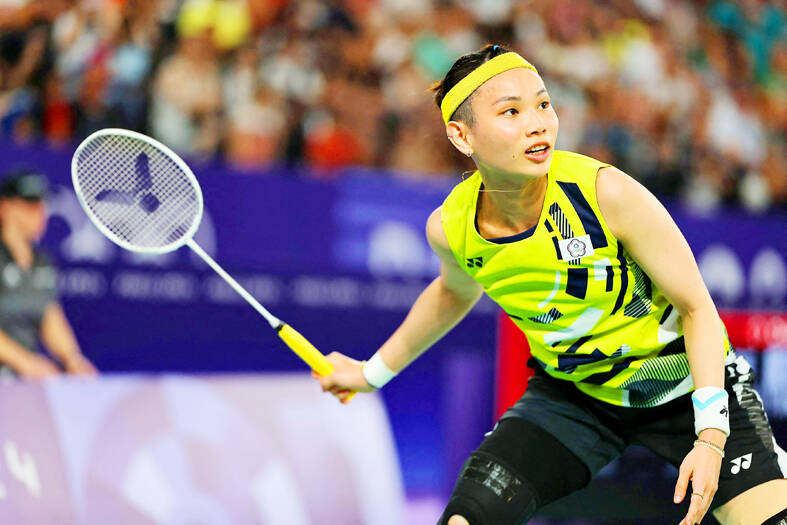Late on Friday night, former world No. 1 female badminton player Tai Tzu-ying (戴資穎) officially announced her retirement on social media, drawing to a close a professional career that has spanned more than half of her life.
The decision was expected, as Tai had said last year’s season would be her last and she has not competed in a tournament since losing to Denmark’s Julie Jakobsen at the China Open in September last year.
She applied for a three-month ranking protection the following month, but did not extend it. Her world ranking fell from No. 5 to unranked by September this year.

Photo: Reuters
The badminton player’s plain farewell was a surprise for many, as it was a stark contrast to her brilliant career.
Tai, 31, in 2014 became the first Taiwanese to win the Badminton World Federation (BWF) Super Series Finals. She went on to dominate the women’s singles rankings for a record 214 weeks between December 2016 and September 2022.
British badminton commentator Gillian Clark once compared Tai’s stature in badminton to that of Michael Jordan in basketball, Tiger Woods in golf and Muhammad Ali in boxing, describing her as “the best women’s singles player I’ve ever had the privilege to watch.”

Photo: Reuters
Tai said she chose to bid farewell this way, because “I don’t want you to see me in such weak form, so I couldn’t give you a perfect retirement ceremony.”
This sense of imperfection, as Tai called it, in a way reflected her career: Dominant as she was, she never captured a gold medal in the four Olympic Games or eight World Championships she joined.
She won her only Olympic medal — a silver in Tokyo in 2020 — and finished runner-up and third at the 2021 and 2022 World Championships respectively.
When a reporter asked Tai about her lack of titles on the biggest stages, she said: “What else do I need to prove?” — and few could argue otherwise.
Over the past decade, Tai has cemented her status as Taiwan’s most iconic athlete.
As of yesterday, she had 1.5 million followers on Instagram and 1.4 million on Facebook.
The Taiwanese athlete with the next-largest social media following is Uni-President 7-Eleven Lions outfielder Chen Chieh-hsien (陳傑憲), who captained Taiwan to last year’s Premier12 championship, the nation’s first major baseball title. He has 409,000 followers.
Tai has displayed her greatness in ways that transcend the court and national boundaries.
When she was world No. 1 in 2017, Tai chose to compete in the Summer Universiade in Taipei rather than the BWF World Championships, which were held at the same time.
“I gave up the World Championships and chose the Universiade, because it’s one of the few chances for Taiwan to host an event of this scale. I felt I had to stay here and support this event with other athletes, hopefully keeping golds in Taiwan,” she said in an official Universiade video. “I want to let Taiwan be seen on the international stage. I think showing Taiwan to the world is a very beautiful thing.”
Tai also weaved her matches with top international players — including China’s Chen Yufei (陳雨菲), South Korea’s An Se-young, Japan’s Akane Yamaguchi, Pusarla Sindhu of India and Ratchanok Intanon of Thailand — into some of the badminton’s most memorable chapters, all while nurturing friendships that endured beyond competitions.
Chen, who beat Tai in the Tokyo 2020 Olympics final, said she was surprised when she received a message from Tai expressing concern and respect for her decision when Chen announced she would take a break from competition.
“If there is one person who made me the Chen Yufei I am today, it must be Tai Tzu-ying,” she said.
Sindhu wrote an emotional note on Instagram after Tai’s announcement, saying that their “quiet friendship” over the years went “beyond rivalry.”
“Watching you step away feels like losing a piece of my own journey. The sport will miss your magic, and so will I. It’s starting to hit me that my generation of players [is] slowly beginning to step away, and nothing really prepares you for that,” Sindhu wrote.

Three Taiwanese airlines have prohibited passengers from packing Bluetooth earbuds and their charger cases in checked luggage. EVA Air and Uni Air said that Bluetooth earbuds and charger cases are categorized as portable electronic devices, which should be switched off if they are placed in checked luggage based on international aviation safety regulations. They must not be in standby or sleep mode. However, as charging would continue when earbuds are placed in the charger cases, which would contravene international aviation regulations, their cases must be carried as hand luggage, they said. Tigerair Taiwan said that earbud charger cases are equipped

UNILATERAL MOVES: Officials have raised concerns that Beijing could try to exert economic control over Kinmen in a key development plan next year The Civil Aviation Administration (CAA) yesterday said that China has so far failed to provide any information about a new airport expected to open next year that is less than 10km from a Taiwanese airport, raising flight safety concerns. Xiamen Xiangan International Airport is only about 3km at its closest point from the islands in Kinmen County — the scene of on-off fighting during the Cold War — and construction work can be seen and heard clearly from the Taiwan side. In a written statement sent to Reuters, the CAA said that airports close to each other need detailed advanced

Tropical Storm Fung-Wong would likely strengthen into a typhoon later today as it continues moving westward across the Pacific before heading in Taiwan’s direction next week, the Central Weather Administration (CWA) said. As of 8am, Fung-Wong was about 2,190km east-southeast of Cape Oluanpi (鵝鑾鼻), Taiwan’s southernmost point, moving westward at 25kph and possibly accelerating to 31kph, CWA data showed. The tropical storm is currently over waters east of the Philippines and still far from Taiwan, CWA forecaster Tseng Chao-cheng (曾昭誠) said, adding that it could likely strengthen into a typhoon later in the day. It is forecast to reach the South China Sea

WEATHER Typhoon forming: CWA A tropical depression is expected to form into a typhoon as early as today, the Central Weather Administration (CWA) said yesterday, adding that the storm’s path remains uncertain. Before the weekend, it would move toward the Philippines, the agency said. Some time around Monday next week, it might reach a turning point, either veering north toward waters east of Taiwan or continuing westward across the Philippines, the CWA said. Meanwhile, the eye of Typhoon Kalmaegi was 1,310km south-southeast of Oluanpi (鵝鑾鼻), Taiwan’s southernmost point, as of 2am yesterday, it said. The storm is forecast to move through central